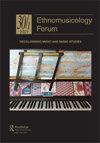Sounding Jewish in Berlin: klezmer music and the contemporary city
IF 0.5
1区 艺术学
0 MUSIC
引用次数: 0
Abstract
craze that emerged in the mid-60s: Latin Bugalú: blending African-American Soul with Cuban dance music. Although popular among the younger Nuyorican musicians, older musicians were more motivated by the commercial success and resultant better pay they could get for Bugalú gigs. In Chapter 9, Miller moves forward to later developments. She focuses on another innovative Nuyorican musician, Ray Barretto and the flute players who worked with him. Here she notes the emergence of female musicians and includes their voices in her research. Miller concludes by arguing that in New York while cubanía thrived, a new, unique and urban performance aesthetic emerged driven by the Cuban and non-Cuban flautists. The city embraced the broader range of approaches to charanga performance with New York bands developing their own signature sounds. There are many ways in which the reader can approach this book. Musicians and Cuban music scholars can learn a great deal from the detailed transcriptions and analysis of which there are many. I thoroughly enjoyed studying these, stopping to play bits and flicking back and forth from one to the next making various comparisons. Miller’s careful, measured explanations directed the reader to notable features of the different players’ approaches to playing. There is a lot of knowledge here that warrants study and re-examination, not just by flute players hoping to embrace the style but all instrumentalists and vocalists who wish to expand their Cuban music vocabulary. It is interesting to see how Miller approaches the task of analysing the music in a way that will provide pertinent information to all readers. She provides a wealth of musical detail with insights into performance practice and techniques. I imagine some of it would be fairly heavy going for non-musicians but throughout there is clarity of thought and careful explanation. Miller weaves together a vast amount of information and detail, keeping the musicians’ voices in the foreground throughout. There is a lot to take in but the book is carefully crafted with reminders of salient points so that the reader does not lose their way. Improvising Sabor is a great example of how to approach a study of musical transformation and identity in a manner which engages both academics and practitioners. Miller has put aside commonly held opinions about performance aesthetic in New York and, from the perspective of the flute within the charanga tradition she has considered the wider world of Cuban music and transformation in New York.柏林的犹太声音:克莱兹默音乐与当代城市
60年代中期兴起的热潮:拉丁Bugalú:将非裔美国人的灵魂与古巴舞曲融合在一起。尽管在年轻的纽约音乐家中很受欢迎,但年长的音乐家更受商业成功的激励,因此他们可以从Bugalú的演出中获得更好的报酬。在第9章中,Miller介绍了后来的发展。她专注于另一位创新的纽约音乐家雷·巴雷托和与他合作的长笛演奏家。在这里,她注意到了女性音乐家的出现,并将她们的声音纳入了她的研究中。米勒最后认为,在古巴蓬勃发展的纽约,古巴和非古巴长笛演奏家推动了一种新的、独特的城市表演美学。这座城市接受了更广泛的查兰加表演方法,纽约乐队开发了自己的标志性声音。读者可以通过多种方式阅读这本书。音乐家和古巴音乐学者可以从详细的转录和分析中学到很多东西,其中有很多。我非常喜欢研究这些,停下来播放一些片段,来回切换,进行各种比较。米勒谨慎、有分寸的解释引导读者注意到不同球员打球方式的显著特点。这里有很多知识值得学习和重新审视,不仅是希望接受这种风格的长笛演奏者,还有所有希望扩大古巴音乐词汇的乐器演奏家和声乐家。有趣的是,米勒是如何以一种能为所有读者提供相关信息的方式来分析音乐的。她提供了丰富的音乐细节以及对表演实践和技巧的见解。我想其中一些对非音乐家来说会相当沉重,但自始至终都有清晰的思路和仔细的解释。米勒将大量的信息和细节交织在一起,使音乐家的声音始终处于前台。这本书有很多值得一读的地方,但它是精心制作的,提醒读者注意要点,这样读者就不会迷失方向。即兴演奏Sabor是一个很好的例子,说明了如何以一种既能吸引学者又能吸引从业者的方式来研究音乐的转变和身份。米勒搁置了人们对纽约表演美学的普遍看法,从查兰加传统中长笛的角度出发,她考虑了古巴音乐和纽约变革的更广阔世界。
本文章由计算机程序翻译,如有差异,请以英文原文为准。
求助全文
约1分钟内获得全文
求助全文
来源期刊

Ethnomusicology Forum
MUSIC-
CiteScore
1.10
自引率
25.00%
发文量
29
期刊介绍:
Articles often emphasise first-hand, sustained engagement with people as music makers, taking the form of ethnographic writing following one or more periods of fieldwork. Typically, ethnographies aim for a broad assessment of the processes and contexts through and within which music is imagined, discussed and made. Ethnography may be synthesised with a variety of analytical, historical and other methodologies, often entering into dialogue with other disciplinary areas such as music psychology, music education, historical musicology, performance studies, critical theory, dance, folklore and linguistics. The field is therefore characterised by its breadth in theory and method, its interdisciplinary nature and its global perspective.
 求助内容:
求助内容: 应助结果提醒方式:
应助结果提醒方式:


